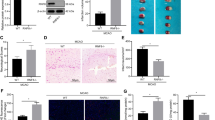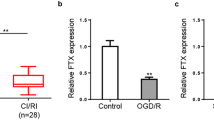Abstract
Background
Stroke is the leading cause of disability and the third leading cause of death in the world, and no effective treatment has been developed. Oxidative stress-induced cell injury and genomic instability is implicated in the pathogenesis of stroke, whose prognosis remains poor.
Methods
A model of cerebral ischemic/reperfusion injury model was established through four artery occlusions. This study was carried out using western blot, flow cytometry and RT-PCR on cell line U251-MG. The cytotoxic effect of H2O2 and expression of LDH, caspase-3, MDA and SOD was analyzed by assay kit.
Results
We found that the expression of WDR26 was induced in cerebral ischemia–reperfusion injury in vivo and the expression of WDR26 was induced by H2O2 in a dose- and time-dependent manner in vitro. WDR26 over-expression significantly suppressed H2O2-induced cell death and caspase-3-mediated apoptosis in U251-MG cells. In contrast, inhibition of WDR26 markedly enhanced cell death in U251-MG cells. In addition, WDR26 regulated oxidative stress response and induced Nrf2/HO-1 pathway.
Conclusions
These findings suggest that WDR26 mediates H2O2-induced oxidative stress and cell injury, possibly by reducing the intrinsic apoptotic pathway and activating Nrf2 and HO-1 in astrocytes.





Similar content being viewed by others
Data availability
Not applicable.
Code availability
Not applicable.
Abbreviations
- ROS:
-
Reactive oxygen species
- WDR26:
-
WD-40 repeat protein 26
- GH:
-
Glycine-histidine
- MAPK:
-
Mitogen-activated protein kinase
- Gβγ:
-
G protein βγ
- LDH:
-
Lactate dehydrogenase
- DMSO:
-
Dimethyl sulfoxide
- MDA:
-
Malondialdehyde
- SOD:
-
Superoxide dismutase
- AS:
-
SiRNA
- HO-1:
-
Heme oxygenase-1
References
Petrea RE et al (2009) Gender differences in stroke incidence and poststroke disability in the Framingham heart study. Stroke 40(4):1032–1037. https://doi.org/10.1161/strokeaha.108.542894
Eltzschig HK, Eckle T (2011) Ischemia and reperfusion–from mechanism to translation. Nat Med 17(11):1391–1401. https://doi.org/10.1038/nm.2507
Ekdahl CT, Kokaia Z, Lindvall O (2009) Brain inflammation and adult neurogenesis: the dual role of microglia. Neuroscience 158(3):1021–1029. https://doi.org/10.1016/j.neuroscience.2008.06.052
Molofsky AV, Deneen B (2015) Astrocyte development: a guide for the perplexed. Glia 63(8):1320–1329. https://doi.org/10.1002/glia.22836
Takuma K, Baba A, Matsuda T (2004) Astrocyte apoptosis: implications for neuroprotection. Prog Neurobiol 72(2):111–127. https://doi.org/10.1016/j.pneurobio.2004.02.001
Hybertson BM et al (2011) Oxidative stress in health and disease: the therapeutic potential of Nrf2 activation. Mol Aspects Med 32(4–6):234–246. https://doi.org/10.1016/j.mam.2011.10.006
Halliwell B (1992) Reactive oxygen species and the central nervous system. J Neurochem 1992(59):1609–1623
Zhao J, Liu Y, Wei X, Yuan C, Yuan X, Xiao X (2009) A novel WD-40 repeat protein WDR26 suppresses H2O2-induced cell death in neural cells. Neurosci Lett 460(1):66–71
Feng Y, Zhang C, Luo Q, Wei X, Jiang B, Zhu H, Zhang L, Jiang L, Liu M, Xiao X (2012) A novel WD-repeat protein, WDR26, inhibits apoptosis of cardiomyocytes induced by oxidative stress. Free Radic Res 46(6):777–784
Xu C, Min J (2011) Structure and function of WD40 domain proteins. Protein Cell 2(3):202–214
Suganuma T, Pattenden SG, Workman JL (2008) Diverse functions of WD40 repeat proteins in histone recognition. Genes Dev 22(10):1265–1268
Zhang C, Zhang F (2015) The Multifunctions of WD40 proteins in genome integrity and cell cycle progression. J Genomics 3:40–50
Zhu Y, Wang Y, Xia C, Li D, Li Y, Zeng W, Yuan W, Liu H, Zhu C, Wu X, Liu M (2004) WDR26: a novel Gbeta-like protein, suppresses MAPK signaling pathway. J Cell Biochem 93(3):579–587
Goto T et al (2016) WDR26 is a new partner of Axin1 in the canonical Wnt signaling pathway. FEBS Lett 590(9):1291–1303. https://doi.org/10.1002/1873-3468.12180
Wei X et al (2010) Overexpression of MIP2, a novel WD-repeat protein, promotes proliferation of H9c2 cells. Biochem Biophys Res Commun 393(4):860–863. https://doi.org/10.1016/j.bbrc.2010.02.099
Sun Z et al (2011) The WD40 repeat protein WDR26 binds Gbetagamma and promotes Gbetagamma-dependent signal transduction and leukocyte migration. J Biol Chem 286(51):43902–43912. https://doi.org/10.1074/jbc.M111.301382
Maletínská L, Blakely EA, Bjornstad KA et al (2000) Human glioblastoma cell lines: levels of low-density lipoprotein receptor and low-density lipoprotein receptor-related protein. Cancer Res 60(8):2300
Jiang C, Yuan F, Wang J, Wu L (2017) Oral squamous cell carcinoma suppressed antitumor immunity through induction of PD-L1 expression on tumor-associated macrophages. Immunobiology 222(4):651–657
Ma Q (2013) Role of nrf2 in oxidative stress and toxicity. Annu Rev Pharmacol Toxicol 53:401–426. https://doi.org/10.1146/annurev-pharmtox-011112-140320
Kamalvand G, Pinard G, Ali-Khan Z (2003) Heme-oxygenase-1 response, a marker of oxidative stress, in a mouse model of AA amyloidosis. Amyloid 10(3):151–159
Lanceta L, Mattingly JM, Li C, Eaton JW (2015) How Heme Oxygenase-1 Prevents Heme-Induced Cell Death. PLoS ONE 10(8):e0134144
Feng Y, Zhao J, Hou H, Zhang H, Jiao Y, Wang J, Wang Y, Sun Y (2016) WDR26 promotes mitophagy of cardiomyocytes induced by hypoxia through Parkin translocation. Acta Biochim Biophys Sin (Shanghai) 48(12):1075–1084
Chuang HW, Feng J-H, Feng Y-L, Wei MJ (2015) An arabidopsis WDR protein coordinates cellular networks involved in light, stress response and hormone signals. Plant Sci 241:23–31
Perez-Cadahia B, Drobic B, Davie JR (2011) Activation and function of immediate-early genes in the nervous system. Biochem Cell Biol 89(1):61–73
Schieber M, Chandel NS (2014) ROS function in redox signaling and oxidative stress. Curr Biol 24(10):R453-462
Kannan K, Jain SK (2000) Oxidative stress and apoptosis. Pathophysiology 7(3):153–163
Khoshnam SE et al (2017) Pathogenic mechanisms following ischemic stroke. Neurol Sci 38(7):1167–1186. https://doi.org/10.1007/s10072-017-2938-1
Paunkov A et al (2019) A bibliometric review of the keap1/Nrf2 pathway and its related antioxidant compounds. Antioxidants (Basel) 8(9):353. https://doi.org/10.3390/antiox8090353
Habtemariam S (2019) The Nrf2/HO-1 axis as targets for flavanones: neuroprotection by pinocembrin, naringenin, and eriodictyol. Oxid Med Cell Longev 2019:4724920. https://doi.org/10.1155/2019/4724920
Zhang M et al (2017) Allicin decreases lipopolysaccharide-induced oxidative stress and inflammation in human umbilical vein endothelial cells through suppression of mitochondrial dysfunction and activation of Nrf2. Cell Physiol Biochem 41(6):2255–2267. https://doi.org/10.1159/000475640
Ryter SW, Choi AMK (2009) Heme oxygenase-1/carbon monoxide: from metabolism to molecular therapy. Am J Respir Cell Mol Biol 41(3):251–260
Zhang X et al (2020) The Nrf-2/HO-1 signaling axis: a ray of hope in cardiovascular diseases. Cardiol Res Pract 2020:5695723. https://doi.org/10.1155/2020/5695723
Liu Z-M, Chen GG, Ng EKW, Leung W-K, Sung JJY, Chung SCS (2004) Upregulation of heme oxygenase-1 and p21 confers resistance to apoptosis in human gastric cancer cells. Oncogene 23(2):503–513
de Oliveira MR et al (2018) Pinocembrin suppresses H2O2-induced mitochondrial dysfunction by a mechanism dependent on the Nrf2/HO-1 Axis in SH-SY5Y cells. Mol Neurobiol 55(2):989–1003. https://doi.org/10.1007/s12035-016-0380-7
Zhao MW, Yang P, Zhao LL (2019) Chlorpyrifos activates cell pyroptosis and increases susceptibility on oxidative stress-induced toxicity by miR-181/SIRT1/PGC-1alpha/Nrf2 signaling pathway in human neuroblastoma SH-SY5Y cells: implication for association between chlorpyrifos and Parkinson’s disease. Environ Toxicol 34(6):699–707. https://doi.org/10.1002/tox.22736
Al-Owais MM et al (2012) Carbon monoxide mediates the anti-apoptotic effects of heme oxygenase-1 in medulloblastoma DAOY cells via K+ channel inhibition. J Biol Chem 287(29):24754–24764. https://doi.org/10.1074/jbc.M112.357012
Funding
This work was supported by National Natural Science Foundation of China (Grant Nos. 82172147; 81571880; 81373147; 30901555; 30972870; 81360080) and Natural Science Foundation of Hunan Province (Grant Nos. 2021JJ30900; 2016JJ2157).
Author information
Authors and Affiliations
Contributions
YL and JZ designed and directed the project. YZ performed the experiments. YZ, YL, KL, YX, SM and JZ analyzed the data. All authors discussed the results and contributed to the final manuscript. YZ wrote the manuscript.
Corresponding author
Ethics declarations
Conflict of interest
The authors report no conflicts of interest.
Ethical approval
All procedures performed in studies involving animals were in accordance with the ethical standards of the institution or practice at which the studies were conducted by Experimental Animal Center of Central South University (Changsha, China), No: 2018sydw0222.
Consent to participate
Not applicable.
Additional information
Publisher's Note
Springer Nature remains neutral with regard to jurisdictional claims in published maps and institutional affiliations.
Rights and permissions
About this article
Cite this article
Liu, Y., Zhao, Y., Li, K. et al. WD-40 repeat protein 26 protects against oxidative stress-induced injury in astrocytes via Nrf2/HO-1 pathways. Mol Biol Rep 49, 1045–1056 (2022). https://doi.org/10.1007/s11033-021-06925-6
Received:
Accepted:
Published:
Issue Date:
DOI: https://doi.org/10.1007/s11033-021-06925-6




